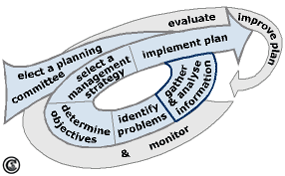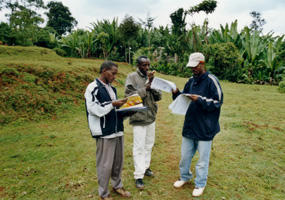Gather and analyse Data and Information
Gathering and analysing information and data - an important step in the Watershed Management planning process
Image Credit: after Heathcote 1998
Mapping of several characteristics of the Gina River catchment
Image Credit: Eck, J. 2004
General considerations
After a planning committee is elected it can start to produce a Watershed Management Plan. The first step is to gather and analyse information about the watershed (see figure 1). The effectiveness of Watershed Management depends on a comprehensive understanding of all individual components of and processes within the ecosystem as well as their interdependence and interconnections (Förch and Schütt 2004 b). A comprehensive analysis of the underlying natural and socio-economic attributes of the watershed is the basis for the development of a watershed management strategy (planning goal) (Heathcote 1998). This includes
- gathering and compiling existing information and data; in most cases reports, statistics and maps of soil surveys, geologic surveys, forest inventories and hydro-meteorologic as well as socio-economic studies that are mostly already available in government agencies;
- confirmation and completion of data during field survey if necessary (Tidemann 1996).
A central file of relevant reports, records and maps should be created and routinely updated (Tidemann 1996). An important tool is a Geographical Information System (GIS) into which the data can be integrated.
Gathering data in the Gina River catchment
In te Gina River catchment data were gathered in the context of an International Class on Watershed Management. In a two-week field survey 20 students from Ethiopia and Germany recorded and mapped several characteristics of the drainage basin with the help of their supervisors (see figure 2). This survey was supplemented by secondary data such as precipitation data. Data were integrated into a GIS and analysed. The results are shown in the chapter ‘Landscape Sensitivity’. For a comprehensive Watershed Management project these data have to be supplemented by socio-economic data of the Gina River catchment.
The gathered and analysed data can reveal different problems within the watershed that have to be identified in the next stage of the planning process.

